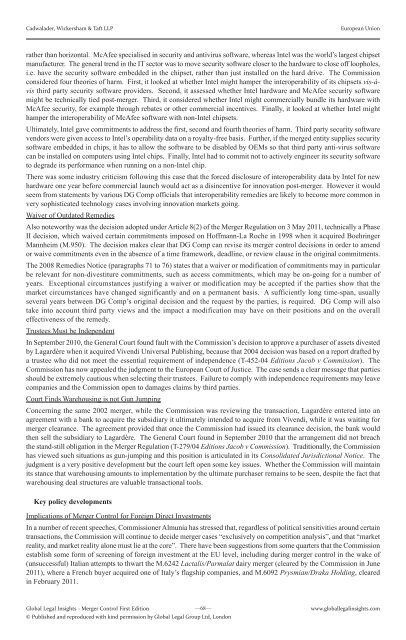Merger Controls First Edition - J Sagar Associates
Merger Controls First Edition - J Sagar Associates
Merger Controls First Edition - J Sagar Associates
You also want an ePaper? Increase the reach of your titles
YUMPU automatically turns print PDFs into web optimized ePapers that Google loves.
Cadwalader, Wickersham & Taft LLP European Union<br />
rather than horizontal. McAfee specialised in security and antivirus software, whereas Intel was the world’s largest chipset<br />
manufacturer. The general trend in the IT sector was to move security software closer to the hardware to close off loopholes,<br />
i.e. have the security software embedded in the chipset, rather than just installed on the hard drive. The Commission<br />
considered four theories of harm. <strong>First</strong>, it looked at whether Intel might hamper the interoperability of its chipsets vis-àvis<br />
third party security software providers. Second, it assessed whether Intel hardware and McAfee security software<br />
might be technically tied post-merger. Third, it considered whether Intel might commercially bundle its hardware with<br />
McAfee security, for example through rebates or other commercial incentives. Finally, it looked at whether Intel might<br />
hamper the interoperability of McAfee software with non-Intel chipsets.<br />
Ultimately, Intel gave commitments to address the first, second and fourth theories of harm. Third party security software<br />
vendors were given access to Intel’s operability data on a royalty-free basis. Further, if the merged entity supplies security<br />
software embedded in chips, it has to allow the software to be disabled by OEMs so that third party anti-virus software<br />
can be installed on computers using Intel chips. Finally, Intel had to commit not to actively engineer its security software<br />
to degrade its performance when running on a non-Intel chip.<br />
There was some industry criticism following this case that the forced disclosure of interoperability data by Intel for new<br />
hardware one year before commercial launch would act as a disincentive for innovation post-merger. However it would<br />
seem from statements by various DG Comp officials that interoperability remedies are likely to become more common in<br />
very sophisticated technology cases involving innovation markets going.<br />
Waiver of Outdated Remedies<br />
Also noteworthy was the decision adopted under Article 8(2) of the <strong>Merger</strong> Regulation on 3 May 2011, technically a Phase<br />
II decision, which waived certain commitments imposed on Hoffmann-La Roche in 1998 when it acquired Boehringer<br />
Mannheim (M.950). The decision makes clear that DG Comp can revise its merger control decisions in order to amend<br />
or waive commitments even in the absence of a time framework, deadline, or review clause in the original commitments.<br />
The 2008 Remedies Notice (paragraphs 71 to 76) states that a waiver or modification of commitments may in particular<br />
be relevant for non-divestiture commitments, such as access commitments, which may be on-going for a number of<br />
years. Exceptional circumstances justifying a waiver or modification may be accepted if the parties show that the<br />
market circumstances have changed significantly and on a permanent basis. A sufficiently long time-span, usually<br />
several years between DG Comp’s original decision and the request by the parties, is required. DG Comp will also<br />
take into account third party views and the impact a modification may have on their positions and on the overall<br />
effectiveness of the remedy.<br />
Trustees Must be Independent<br />
In September 2010, the General Court found fault with the Commission’s decision to approve a purchaser of assets divested<br />
by Lagardère when it acquired Vivendi Universal Publishing, because that 2004 decision was based on a report drafted by<br />
a trustee who did not meet the essential requirement of independence (T-452-04 <strong>Edition</strong>s Jacob v Commission). The<br />
Commission has now appealed the judgment to the European Court of Justice. The case sends a clear message that parties<br />
should be extremely cautious when selecting their trustees. Failure to comply with independence requirements may leave<br />
companies and the Commission open to damages claims by third parties.<br />
Court Finds Warehousing is not Gun Jumping<br />
Concerning the same 2002 merger, while the Commission was reviewing the transaction, Lagardère entered into an<br />
agreement with a bank to acquire the subsidiary it ultimately intended to acquire from Vivendi, while it was waiting for<br />
merger clearance. The agreement provided that once the Commission had issued its clearance decision, the bank would<br />
then sell the subsidiary to Lagardère. The General Court found in September 2010 that the arrangement did not breach<br />
the stand-still obligation in the <strong>Merger</strong> Regulation (T-279/04 <strong>Edition</strong>s Jacob v Commission). Traditionally, the Commission<br />
has viewed such situations as gun-jumping and this position is articulated in its Consolidated Jurisdictional Notice. The<br />
judgment is a very positive development but the court left open some key issues. Whether the Commission will maintain<br />
its stance that warehousing amounts to implementation by the ultimate purchaser remains to be seen, despite the fact that<br />
warehousing deal structures are valuable transactional tools.<br />
Key policy developments<br />
Implications of <strong>Merger</strong> Control for Foreign Direct Investments<br />
In a number of recent speeches, Commissioner Almunia has stressed that, regardless of political sensitivities around certain<br />
transactions, the Commission will continue to decide merger cases “exclusively on competition analysis”, and that “market<br />
reality, and market reality alone must lie at the core”. There have been suggestions from some quarters that the Commission<br />
establish some form of screening of foreign investment at the EU level, including during merger control in the wake of<br />
(unsuccessful) Italian attempts to thwart the M.6242 Lactalis/Parmalat dairy merger (cleared by the Commission in June<br />
2011), where a French buyer acquired one of Italy’s flagship companies, and M.6092 Prysmian/Draka Holding, cleared<br />
in February 2011.<br />
Global Legal Insights <strong>Merger</strong> Control <strong>First</strong> <strong>Edition</strong><br />
—68—<br />
© Published and reproduced with kind permission by Global Legal Group Ltd, London<br />
www.globallegalinsights.com


